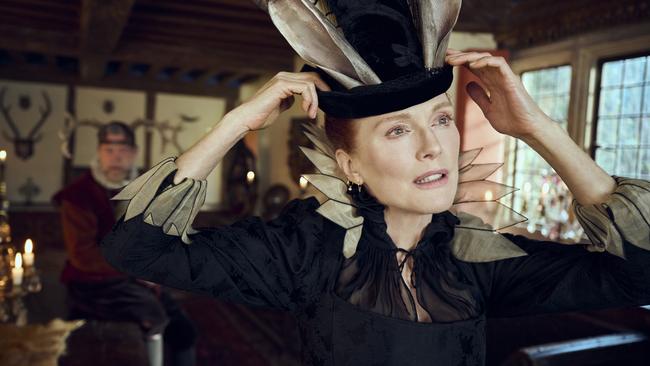This leaves Bridgerton in the dust
Julianne Moore is on delectable form as a scheming 17th century social climber in Mary & George

Mary & George
Binge
Now we are feasting! Here is one of those period dramas in which the actors are decked out in gorgeous 17th-century garb but speak in modern parlance. It’s kind of a spiritual successor to Tony McNamara’s The Great, with all its effing and blinding, and with a delicious dollop of the sex-obsessed Bridgerton (though the nookie here is almost always for power, not pleasure). The seven-part miniseries stars Oscar-winner Julianne Moore — who is relishing this role — alongside Nicholas Galitzine (Hollywood’s next great heart-throb). They play the real-life mother-and-son duo Mary and George Villiers, pictured below, who, through a heady mixture of sex and scheming, climb the ranks in King James’s court. The action kicks off when Mary’s beastly, abusive husband — also named George — dies and cuts her out of the will. Mary, who was not born to nobility and is entirely reliant on the men she is married to and her male children, must spring into action. Her firstborn son, John, is mentally handicapped, and we later learn, a violent liability. But her second-born, George, is blindingly gorgeous. So, she ships him off to France for a whirlwind lesson on all things ménage a trois, in the hopes that he will find a way to seduce the “surly Scottish sodomite” King James I (a bawdy Tony Curran). It’s all intrigue, backstabbing, and poisoning via prunes. Everything about this show is scrumptious: Moore and Galitzine’s chemistry is sizzling; the script, penned by Killing Eve’s DC Moore, will make you laugh dangerously hard; and it looks sublime.
The Regime
Binge
Kate Winslet delivers a barnstorming performance in The Regime, but, regrettably, the rest of the show falls apart. In this unwieldy political satire by Will Tracy (known for The Menu and Succession) and director Stephen Frears (Dangerous Liaisons), Winslet portrays Elena Vernha, the chancellor of an unnamed Middle Europe country where a rebellion simmers among neglected, starving citizens. Elena is a live wire with a fixed, lemon-sucking expression and an oppressively sweet cadence (she addresses her country as “my loves”). She is also a hypochondriac and lives in constant fear of catching the same lung disease that killed her father. Paranoia sets in when she suspects a lethal mould infestation in the palace she rules, leading her to hire Corporal Herbert Zuback (Matthias Schoenaerts) as her mould expert. The corporal, nicknamed The Butcher for slaughtering miners protesting poor working conditions, takes a dangerous turn when Elena falls for his charms. He is promoted from palace fumigator to a political adviser. While the show desperately wants to say something, it struggles to articulate a clear point. Vague ideas about the dangers of authoritarianism are thrown around, but they never fully materialise. Despite the top-notch performances and impressive visuals, the show becomes a bit tedious.
Dune
Brollie
Last week saw the release of Dune: Part Two, the second instalment of Denis Villeneuve’s adaptation of the 1965 Frank Herbert novel — a faithful, breathtaking success. But so much of the appeal of Dune was in its unadaptability. David Lynch was famously so embarrassed about the 1984 film that he disavowed it and asked to have his name removed from the credits. Then there was Chilean surrealist Alejandro Jodorowsky’s attempt, in the ’70s, to make a 14-hour version of the film starring Salvador Dali (who requested $100,000 per hour on set, Orson Welles, Gloria Swanson and Mick Jagger — as chronicled in the brilliant 2014 documentary Jodorowsky’s Dune. One adaptation that seems to go ignored is the Sci-Fi Channel’s 2000 miniseries, starring William Hurt. This is not a perfect television show by any stretch. But it is a fun, charming oddity. There’s something quite thrilling about going back to the early 2000s and getting a feel for the gloriously cheesy SFX of the era. It doesn’t hurt that this series was shot by the Oscar-winning Apocalypse Now cinematographer Vittorio Storaro.
Dark
Netflix
For those who have watched Stranger Things and thought, “I want this but more depressing, complicated, and German,” try Dark. The less you know going into this freaky, mind-melting series, the better. In brief, the story centres on a handful of families in the fictional East German town of Winden, which is shadowed by a nuclear power plant. Winden is rocked by the unexplained suicide of an artist and father, Michael, and the disappearance of a young boy, Mikkel, the son of the town’s top police officer. While these are the two central mysteries that keep the show ticking along, there is plenty more to it. Namely, time travel: by the end of the first season, Dark is set across four timelines (2019, 1986, 1953, and 2052) which can be hard to keep up with, but stick with it. This is the kind of incredibly knotty show that you cannot watch passively. It demands your full attention, and it rewards it generously.


To join the conversation, please log in. Don't have an account? Register
Join the conversation, you are commenting as Logout